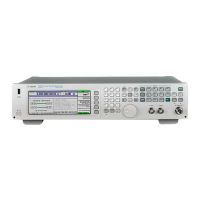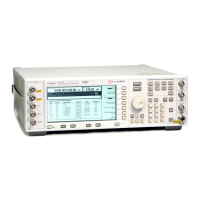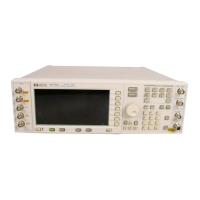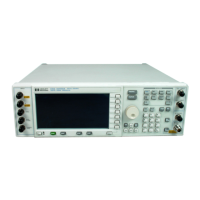Agilent N5181A/82A MXG Signal Generators SCPI Command Reference 149
Component Test Digital Commands
Dual ARB Subsystem–Option 651/652/654 ([:SOURce]:RADio[1]:ARB)
Example
:RAD:ARB:MARK "Test_Data",1,40,100,2
The preceding example sets marker 1 on the first point, 40, the last point, 100, and every third point
(skip 2) between 40 and 100 (assuming the Test_Data file has at least 100 points).
:MDEStination:ALCHold
Supported N5182A with Option 651/652/654
CAUTION Incorrect automatic level control (ALC) sampling can create a sudden unleveled
condition that may create a spike in the RF output potentially damaging a DUT or
connected instrument. Ensure that you set markers to let the ALC sample over an
amplitude that accounts for the high power levels within the signal.
[:SOURce]:RADio[1]:ARB:MDEStination:ALCHold NONE|M1|M2|M3|M4
[:SOURce]:RADio[1]:ARB:MDEStination:ALCHold?
This command enables or disables the marker ALC hold function for the selected marker. For setting
markers, see “:MARKer[:SET]” on page 147.
Use the ALC hold function when you have a waveform signal that incorporates idle periods, or when
the increased dynamic range encountered with RF blanking is not desired. The ALC leveling circuitry
responds to the marker signal during the marker pulse (marker signal high), averaging the modulated
signal level during this period.
The ALC hold function operates during the low periods of the marker signal. The marker polarity
determines when the marker signal is high. For a positive polarity, this is during the marker points.
For a negative polarity, this is when there are no marker points. For setting a marker’s polarity, see
“:MPOLarity:MARKer1|2|3|4” on page 151.
NOTE Do not use the ALC hold for more than 100 ms, because it can affect the waveform’s output
amplitude.
The marker signal has a minimum of a two- sample delay in its response relative to the waveform
signal response. To compensate for the marker signal delay, offset marker points from the waveform
sample point at which you want the ALC sampling to begin.
The ALC hold setting is part of the file header information, so saving the setting to the file header
saves the current marker routing for the waveform file.
NOTE A waveform file that has unspecified settings in the file header uses the previous waveform’s
routing settings.
Range <marker>: 1–4
<first_Point>: 1–number of waveform points
<last_point>: <first_Point>–number of waveform points
<skip_count>: 0–number of points in the range
Key Entry Set Marker on Range Of Points Marker 1 2 3 4 First Mkr Point Last Mkr Point
# Skipped Points Apply to Waveform

